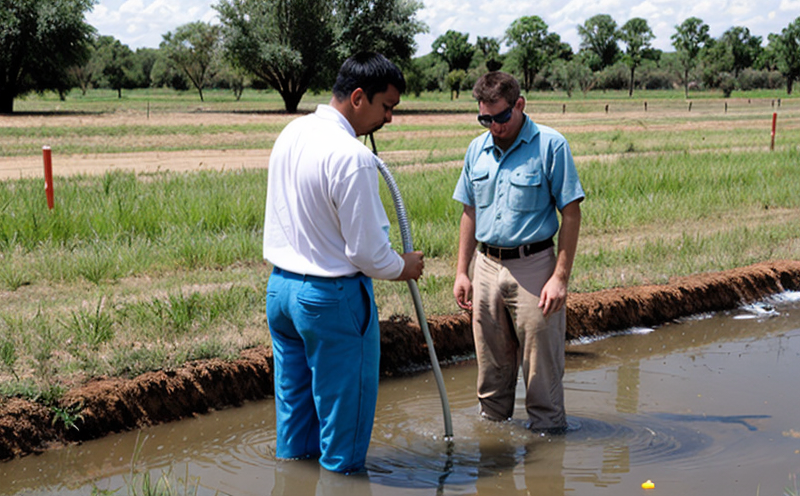ASTM D3919 Selenium Determination Test in Groundwater
The ASTM D3919 test method is specifically designed for the determination of selenium in groundwater. This service ensures compliance with environmental regulations and supports sustainability goals by providing accurate, reliable results that are critical for decision-making.
Selenium, a naturally occurring element found in various geological formations, can pose significant risks to aquatic ecosystems if it enters water bodies through contaminated groundwater. Groundwater serves as the primary source of drinking water for millions worldwide, making the monitoring and control of selenium concentrations essential.
The ASTM D3919 test follows a multi-step process that includes sample collection, preparation, digestion, and analysis using an atomic absorption spectrophotometer (AAS) or inductively coupled plasma optical emission spectrometry (ICPOES). This method is capable of detecting selenium concentrations as low as 0.2 μg/L.
Proper sample handling and preparation are crucial to ensure accurate test results. Samples should be collected from representative locations, allowing for a comprehensive understanding of the distribution and concentration levels of selenium in the groundwater. Compliance with ASTM D3919 ensures that all procedural steps adhere to recognized industry standards, enhancing the credibility and reliability of the test.
The significance of this test extends beyond mere compliance; it also contributes to broader environmental stewardship initiatives. By identifying potential sources of contamination and tracking changes over time, organizations can implement targeted mitigation strategies. This proactive approach helps prevent adverse impacts on human health and the environment, aligning with global sustainability goals.
| Use Case/Application | Description |
|---|---|
| Regulatory Compliance | Demonstrating adherence to environmental regulations such as the Safe Drinking Water Act. |
| Risk Assessment | Evaluating potential risks associated with selenium contamination in groundwater. |
| Environmental Monitoring | Tracking changes in selenium concentrations over time for ongoing management. |
| Sustainable Water Management | Supporting sustainable practices by ensuring water quality meets safety standards. |
- Evaluating the effectiveness of remediation efforts.
- Determining compliance with international standards like ISO 17025 and ASTM D3919.
By leveraging this testing service, organizations can ensure that their operations do not contribute to environmental degradation. The accurate identification and quantification of selenium in groundwater enable informed decision-making processes aimed at protecting public health and preserving natural resources.
Our laboratory adheres strictly to ASTM D3919 guidelines, employing experienced technicians equipped with state-of-the-art equipment. This commitment ensures that clients receive precise results, enhancing their ability to manage risks effectively and contribute positively to environmental sustainability.
Benefits
The ASTM D3919 Selenium Determination Test in Groundwater offers several key benefits that are vital for maintaining compliance with environmental regulations, ensuring public health, and supporting sustainable practices:
- Compliance Assurance: Ensures adherence to local, national, and international standards, such as the Safe Drinking Water Act (SDWA) and ISO 17025.
- Risk Mitigation: Identifies potential risks associated with selenium contamination in groundwater, allowing for timely interventions.
- Data Integrity: Provides reliable data that can be used to make informed decisions regarding water quality management.
- Sustainability Support: Contributes to broader sustainability goals by helping organizations maintain environmentally responsible practices.
The accurate determination of selenium levels in groundwater is essential for protecting public health and the environment. By offering this service, we empower clients with the necessary tools to manage risks effectively and contribute positively to environmental stewardship initiatives.
Environmental and Sustainability Contributions
The ASTM D3919 Selenium Determination Test in Groundwater plays a crucial role in supporting environmental sustainability by ensuring that organizations comply with relevant regulations and standards. By providing accurate selenium concentration data, this test helps prevent contamination of water resources, which is vital for maintaining public health.
Groundwater serves as the primary source of drinking water for millions worldwide, making it critical to monitor and control the presence of harmful elements like selenium. The ASTM D3919 method ensures that samples are analyzed accurately, allowing organizations to take appropriate actions if contamination is detected. This proactive approach helps prevent adverse impacts on human health and the environment.
Our laboratory's adherence to ASTM D3919 guidelines demonstrates a commitment to environmental stewardship. By ensuring compliance with recognized industry standards, we enhance the credibility and reliability of test results. These accurate data points enable organizations to make informed decisions regarding water quality management, thereby supporting broader sustainability goals.
| Use Case/Application | Description |
|---|---|
| Environmental Impact Assessment | Evaluating the environmental impact of various activities on groundwater quality. |
| Sustainable Water Resource Management | Supporting sustainable practices by ensuring water resources meet safety standards. |
| Risk Assessment and Mitigation | Evaluating potential risks associated with selenium contamination in groundwater and implementing mitigation strategies. |
| Remediation Effectiveness Monitoring | Determining the effectiveness of remediation efforts aimed at reducing selenium levels in contaminated groundwater. |
The accurate identification and quantification of selenium in groundwater enable informed decision-making processes aimed at protecting public health and preserving natural resources. By offering this service, we contribute to broader sustainability goals by helping organizations maintain environmentally responsible practices.





